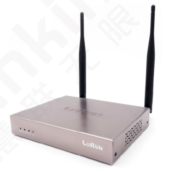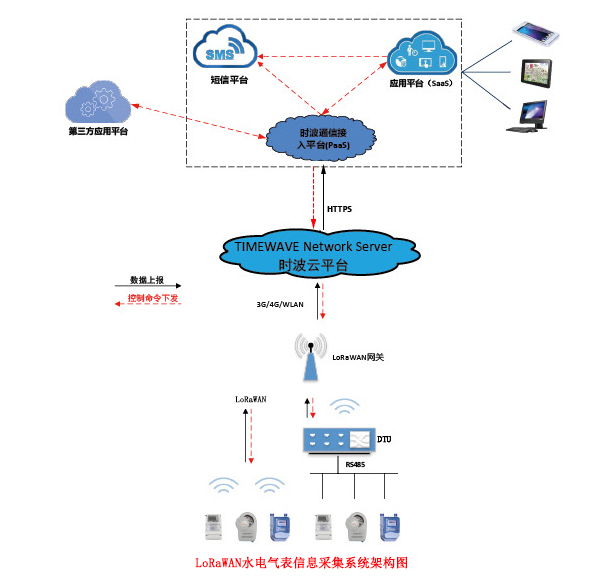Industry News
The technical principle of LoRaWAN and its application in water electricity and gas
With the gradual development of the IoT, many IoT applications need to be widely deployed because of their small data packets and high tolerance for delay. Or it is located in remote, basement, underground and other places with serious shielding, and the transmission signal of existing wireless communication or mobile communication technology is not easy to reach. For the above applications, develop and issue long-distance low-power communication technology, collectively referred to as Low Power Wide Area Network (LPWAN). LPWAN has the advantages of low power consumption, long distance and super large connection. Therefore, it is applicable to the application fields that need to be built in a wide range and transmit small amounts of data. This feature is very consistent with the application requirements of information acquisition of intelligent electricity meters. LPWAN can be divided into two camps according to the frequency band used: authorized frequency band and non authorized frequency band. The development of non authorized frequency band LPWAN technology is earlier, and the main technology is LoRaWAN.
一、About LoRaWAN
LoRaWAN is a set of communication protocols and system architecture designed for LoRa long-distance communication network. It defines how data is transmitted in the LoRaWAN network (the network here refers to nodes, gateways and servers), and defines the type of message, data frame structure and security encryption method. The specific operation of network access is introduced, and the difference between master and slave is explained.

In terms of protocol and network architecture design, LoRaWAN fully considers several factors such as node power consumption, network capacity, security and diversity of network applications.
二、Lorawan network architecture
The following is the network architecture diagram of LoRa

A LoRaWAN network architecture includes four parts: terminal, base station, NS (network server), and application server. Star and cellular network topologies are used between the base station and the terminal. Due to the long distance characteristics of LoRa, single hop transmission can be used between them. The terminal node can send to multiple base stations at the same time. The base station forwards the LoRaWAN protocol data between the NS and the terminal. The LoRaWAN data is carried on the LoRa RF transmission and TCP/IP respectively.
三、An overview of the LORAWAN protocol
1、Classification of terminal nodes
In terms of technical specifications, LoRaWAN transmission rate is about 30bit/s-50kbit/s, transmission distance is about 2=5km in urban areas and up to 15km in suburban areas. It supports bidirectional transmission. The transmission mode can be divided into Baseline (Class A), Beacon (Class B) and Continuous (Class C) according to the delay requirements and power consumption. Among them, Class A mode can only be transmitted when the terminal device sends a request, which has low power consumption and is used in water meters and gas meters. Class C transmits data continuously with short transmission delay. Class C2 is generally used in electricity meters.
2、Uplink and downlink transfers of terminal nodes
This is the sequence diagram of the uplink and downlink of Class A. At present, RX1 of the receive window generally starts 1 second after the uplink. RX2 of receiving window starts 2 seconds after uplink.

Class C and A are basically the same. Only when Class A is sleeping, it opens the receive window RX2.

3. Networking of terminal nodes
There are two networking methods for terminal access: Over the Air Activation (OTAA) and Activation by Personalization (ABP).
Commercial LoRaWAN networks generally follow the OTAA activation process to ensure security. In this way, DevEUI, AppEUI, and AppKey should be prepared.

DevEUI is a globally unique ID similar to IEEE EUI64, which identifies a unique terminal device. This is equivalent to the MAC address of the device.
AppEUI is a globally unique ID similar to IEEE EUI64, which identifies a unique application provider..
AppKey is assigned to the terminal by the application owner.
After the terminal initiates the networking join process, it sends the networking command. After the NS (network server) confirms that there is no error, it will make a networking reply to the terminal and assign the network address DevAddr (32-bit ID). Both parties use the relevant information in the networking reply and the AppKey to generate the session keys NwkSKey and AppSKey, which are used to encrypt and verify the data.
If the second networking method, ABP activation, is used, the three LoRaWAN communication parameters DevAddr, NwkSKey, and AppSKey are directly configured, and the join process is no longer required. In this case, the device can send application data directly.
4、 Data Transceiver
After accessing the network, the application data is encrypted.
LoRaWAN stipulates that there are two types of data frames: Confirmed or Unconfirmed, that is, response required and no response required. The manufacturer can select the appropriate type according to the application needs.
In addition, we can see from the introduction that one of the major considerations of LoRaWAN design at the beginning is to support the diversity of applications. In addition to using AppEUI to divide applications, FPort application ports can also be used to process data separately during transmission. The value range of FPort is (1~223), which is specified by the application layer.
5、 ADR mechanism
There is a spread spectrum factor in LoRa modulation. Different spread spectrum factors have different transmission distance and transmission rate. It does not affect data transmission.
In order to expand the capacity of LoRaWAN network, a LoRa adaptive data rate - ADR mechanism is designed on the protocol. Devices with different transmission distances will use the fastest data rate possible according to the transmission conditions. This also makes the overall data transmission more efficient.
四、Lorawan's features
LoRaWAN is characterized by wireless transmission, strong anti-interference capability, encrypted communication, wide coverage, low power consumption, large connection and low cost.
Long distance: It benefits from the gain of spread spectrum modulation and forward error correction code. LoRa achieves about twice the communication distance of cellular technology.
Large capacity: the Internet of Things has many nodes. A LoRaWAN network can easily connect tens of thousands of nodes.
Easy capacity expansion: When a LoRaWAN network needs to increase capacity, add a gateway.
Security: LoRaWAN is a double encrypted Internet of Things. It is suitable for information application of electric energy meter.
五、Technical specifications for gateways and modules
1、Gateway




2、Lorawan module


六、The measured data
1、Pull distance test

At a straight-line distance of 3.7KM from Wuhan Adic, the signal strength is - 94 and the signal-to-noise ratio is - 6.0. The data packets of the internal antenna and external antenna are normal.
2、Penetration test in the building: The gateway is installed in the surface well on the 15th floor of Building 4, Phase 1, Huangjinkou Binjiang Garden
In the data in the above table, the signal strength is above - 100dbm (far greater than the module's receiving sensitivity limit of - 139dbm), and the signal to noise ratio is above - 10, which can achieve two-way reliable communication. Therefore, if the gateway is placed on the 15th floor, the signal coverage of the entire 32nd floor can be achieved.
3、Data upload success rate test
Test conditions: 120 meters, a gateway (8-channel half duplex)


It can be seen from the above test data that 120 tables can upload data within 3 minutes. The average success rate is above 99%.
Conclusion:
1、The use of built-in antenna in the city can ensure normal communication within 2-3km. The external antenna can be used to achieve a longer distance.
2、It can penetrate 10-15 floors.
3、An 8-channel half duplex gateway with 120 meters is used. Complete reliable data transmission within 3 minutes. The 16 channel half duplex gateway can realize reliable data transmission of more than 200 meters.
LoRaWAN technology can effectively realize the collection of water and electricity meter information.

For this, we launched a series of LoRaWAN products:
Three-phase communication module

Single-phase communication module

Collector

Single-phase electronic meter

Single-phase charge control intelligent meter

Single-phase power monitor

Three-phase electronic meter

Three-phase charge control intelligent meter

Smart socket










 Online service
Online service

 Hotline
Hotline

 WhatsApp
WhatsApp
